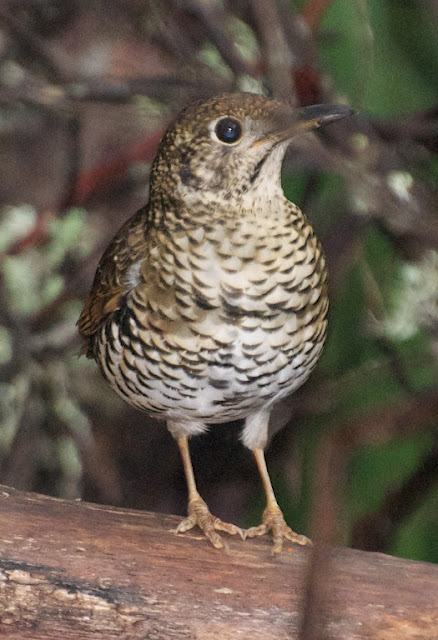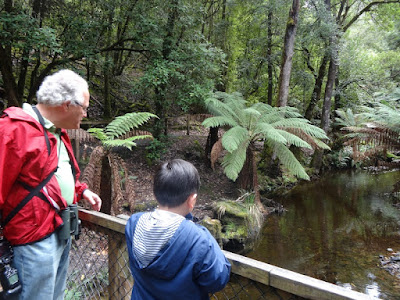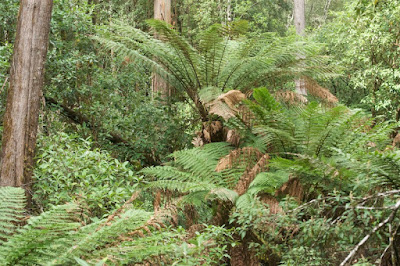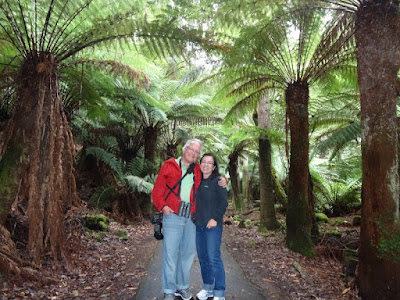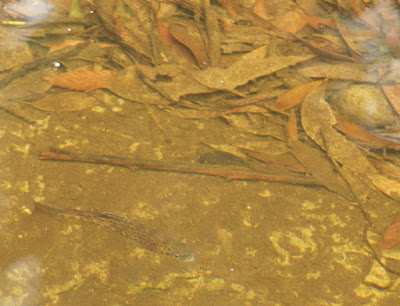Our morning was fairly damp and misty, with clouds hanging low over Lake St.Clair.
The weather, though, seemed to fit the forest itself. We followed the encouragingly-named Platypus Bay trail through stands of eucalypts and tree ferns, towards a series of platypus viewing points. The eucalypts are probably Black Peppermint (Eucalyptus amygdalina), a widespread Tasmanian endemic.
Black Peppermint can grow to 30 metres high, and some cut trees along the trail were substantial indeed.
Though Tasmania is famous for its numerous botanical oddities, one of the most well-known Australian plant genera is poorly represented there. Of the over 170 Australian species in the genus Banksia, only two occur there. Only one, the Silver Banksia (Banksia marginata), is common and widespread. To make up for it, Silver Banksia is highly variable in size, leaf shape and flower colour (besides the yellow seen here, it can be white or even pink).
Platypuses are shy animals, and the platypus lookouts act as a sort of hide from which lucky viewers can peep at them through slats in a wooden wall as they splash about in the lake. Despite staring for some time at promising-looking but inert lumps and a few ripples on the water's surface, we never did see one.
Back at our cabin, I had time for a brief bird walk before we set out on our drive across the island back to Hobart. This is a poor shot, but the bird, a Black-headed Honeyeater (Melithreptus affinis), is a Tasmanian endemic.
I had better looks at another endemic, the Tasmanian Scrubwren (Sericornis humilis), which at least kept to ground level.
This Bassian Thrush (Zoothera lunulata) is not an endemic - it is widespread in eastern Australia - but (like most Zoothera thrushes) it is not always easy to see well, so I was very pleased to come across this cooperative individual.
This is a genuine thrush, one of Australia's two native thrushes, both once thought to be races of the widespread Asian Scaly or White's Thrush (Z. dauma). It is one of the comparatively few Australian songbirds that belongs to a widespread Northern Hemisphere family, rather than to a comparatively ancient Australasian one. Despite the fact that some of the latter - shrike thrushes and quail-thrushes - have "thrush" in their names, they are no more thrushes than koalas are bears.
By now it was time to move on, after a short visit to the Interpretative Centre (Ryan is demonstrating how to clean your boots to avoid contaminating the native forest). There was, though, one more stop that I planned to make, at a spot fondly remembered from my first trip to Tasmania in 1974.
Russell Falls is located in Mount Field National Park, at the end of a short, easy trail that must be one of the loveliest walks in all Tasmania.
The things that makes the trail so lovely, in my opinion, are not just the falls themselves (handsome as they are) but the masses of lacy tree ferns that dominate the lower layers of the forest, particularly along the river's edge.
The dominant forest tree is Mountain Ash or Swamp Gum (Eucalyptus regnans). Although some of the trees along the trail are quite substantial none reach the towering heights of the largest of the species; the biggest known specimen, the Centurion Tree in Huon Valley, stands 99.6 metres (326 feet) tall.
It is the ferns, though, that make the forest truly magical.
Most, if not all, of the tree ferns at Russell Falls are Manferns (Dicksonia antarctica), distinguished by their rough, fibrous trunk and rather stiff foliage (compared to the slender, lacy tree ferns in the genus Cyathea). Dicksonia and its relatives are ancient plants indeed - the family Dicksoniaceae ranges back to the late Triassic.
At one point along the trail, the ferns formed an archway over our heads...
...a good place for Ryan to take a romantic portrait of Grandma and Grandpa.
At some points along the trail there are glow-worm grottoes, decorated with the hunting snares of bioluminescent fly larvae (similar to the ones we had seen at Marakoopa Cave two days before), but they were not visible in daylight.
Among the smaller ferns, the coarse leaves of Kangaroo Fern (Microsorum diversifolium) were a standout; this is a species common to both eastern Australia and New Zealand.
Fallen limbs along the trail were draped with a range of mosses and other plants...
...as well as shelf fungi.
The falls themselves (despite the botanical competition) are certainly worth the walk - a particularly lovely cascade, as I remembered from 1974. As countless other have surely done, we took time to pose in front of them.
On the way back we checked out the river for signs of life.
We did turn up one animal, an (introduced) Brown Trout (Salmo trutta), just visible in the lower left of this photo.
With that, we re-emerged from the trail, took a last look back...
and continued our drive to Hobart with only a brief late-afternoon stop along the Derwent to check out some distant, non-photogenic waterfowl, while Eileen made sure that our rental car was ship-shape and ready to be turned in at the airport.











